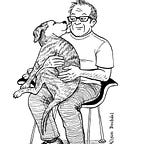Tarantino’s Happy Ending
Sharon Tate, Abigail Folger, Jay Sebring and Wojciech Frykowski were murdered by the Manson Family four weeks before my fifth birthday. We were visiting my grandparents in Mahanoy City, a small Pennsylvania coal mining town, when the story hit the news; even in those old days, the headlines were immediate. Of course, I was oblivious, but by the time Helter Skelter came out in paperback in 1976, I was eager to read anything my older sister was reading.
“It was so quiet, one of the killers would later say, you could almost hear the sound of ice rattling in cocktail shakers in the homes way down the canyon.” This opening line, even at twelve, seemed worthy of my study, although now it reads more like a junior league attempt to mimic Joan Didion than an accurate quote from these killers. I understood what a cocktail shaker was — my father was a university professor after all — and had a tentative sense of what a canyon might be, although that was a more foreign concept. Most of all, I studied the black and white photo section in the center of the book, with its melodramatic captions that sounded like omnious without holding much meaning at all. “Only in death would she receive star billing,” one caption said of Sharon Tate. This sounded important, almost contractual, but I couldn’t quite manage to connect the cause and effect here. I still can’t. (Tate had, in fact, received star billing before death.)
That chilling sense of chaos, from that time, from my childhood, from that entire era of trying to make sense and order of things that have no real sense or order, has shaped more of my life than I may realize. It may be why I’ve always felt more stability at the center of disasters than I do in the calm lull that falls in between. It’s why I’m particularly mesmerized by the best of Didion’s work, which strives to find order and connection in events that are beyond meaning. And it may be why I was shaken, to tears, by Quentin Tarantino’s latest film, Once Upon a Time…in Hollywood. (Full disclosure: I was also coming off the end of a six day course of prednisone.)
Tarantino has always thrived on chaos, on tricking his audience into feeling they were watching completely parallel but unrelated vignettes, and then finally revealing the master plan that weaves everything neatly together. But this is next level. At the center of the story is Leonardo DiCaprio as Rick Dalton, a working actor with a house in the hills, who still feels that he’s a colossal failure. Every turn of his career, good or bad, has been at the hands of luck, with every casting choice dependent on the illness, health and availability of other actors who are higher on the list. To people like his stunt double, played by Brad Pitt, Rick seems sucessful. But from his own perspective he is always just one bad role away from calling it quits.
Although DiCaprio and Dalton are the center of the film, the bigger picture is a sprawling, complex portrait of that point in time. Early in the film, we learn that Dalton’s new neighbor’s are Roman Polanski and Sharon Tate and we follow Tate as she strolls through Hollywood to buy a rare copy of Tess of the d’Urbervilles as a gift for her husband, then ducks into a theater to watch herself on screen with Dean Martin in the latest Matt Helm film. We also get to eavesdrop at a Playboy mansion party as Steve McQueen fills Joey Heatherton in on the gossipy back story of Sharon’s relationships with both Polanski and hairdresser Jay Sebring, while Tate dances with abandon between her friends Michelle Phillips and Cass Elliott. This last bit strikes the perfect balance between parody and homage, as do many of the other layers of the film in which real Hollywood melds with Tarantino’s own vision, including some remarkable reproductions of old Hollywood productions in which the current cast appears alongside their long-deceased contemporaries.
There’s a darker side to all of this. Pitt’s character is resigned to his position as a stuntman and gofer living in a trailer with his pit bull companion, Brandy. He feels lucky enough to get to drive his boss’s car around town and to flirt with young hippy women young enough to be his daughter. One of young women, played by the remarkable Margaret Qualley, leads him back to the Spawn Movie Ranch, the desert location where he once filmed Westerns, now occupied by the Manson Family. In a classic Tarantino sequence, he surveys this location from his past, now populated by a counter-culture that make him feel square, and insists on crossing past them to check on the ranch’s owner, who he hasn’t seen in eight years.
This isn’t a retelling of historical events, but more of a highly entertaining essay on fate, redemption and our capacity to change if we are lucky enough to get older. Within this framework, Tarantino offers commentary on the role of women in Hollywood, with a young child actress delivering a blistering but compassionate lesson to Rick Dalton as they wait set-side for their next take. He also nods to his own messy past, with several gratuitous shots of women’s dirty feet and two lengthy tracking shots from the back of a speeding car which mirror, too perfectly, the now notorious footage from Uma Thurman’s Kill Bill accident.
How does this all possibly come together? The perfectly choregraphed chaos of the final scenes manage to bring even the most disparate aspects of these threads into play. It’s brutal and comic and finally, most remarkably, incredibly moving, which is something I would have never expected to say about a Tarantino film. I could explain myself, but I don’t want to spoil it for anyone else.
